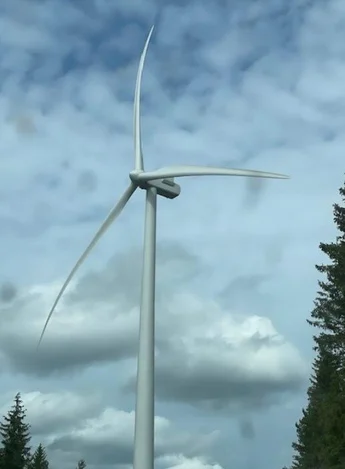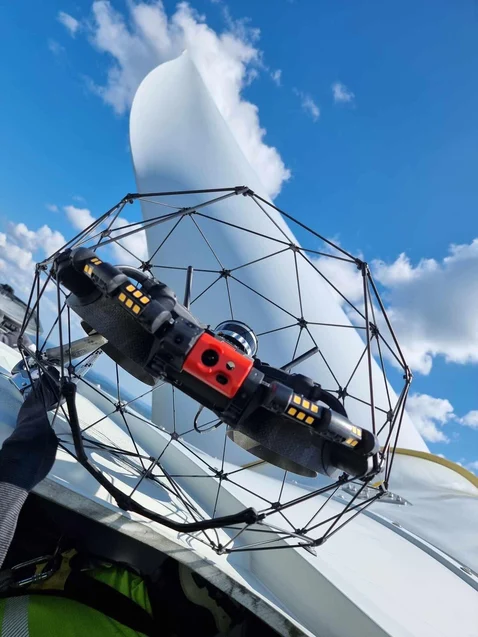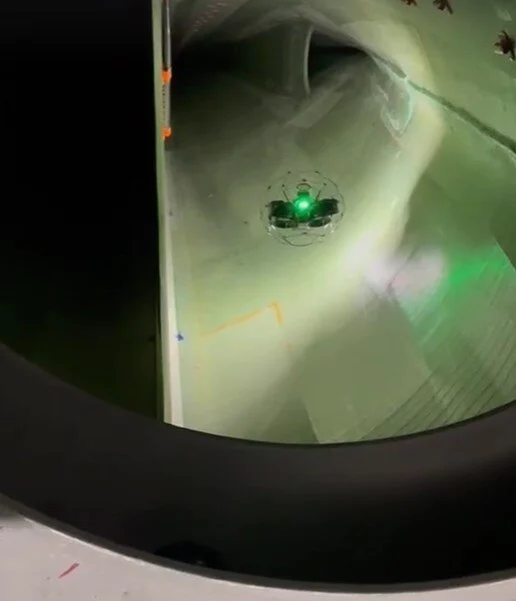Wind Turbine Blade Inspections with the Elios 3
Discover how the Elios 3 was used to showcase the advantages of drone-based wind turbine blade inspections, delivering results in just one day instead of five!
Key Benefits at a Glance
|
Safety Inspecting the inside of a wind turbine blade involves working at height and in tight spaces. The Elios 3 reduces these risks by eliminating the need for human entry into the blade, making it a much safer option. |
Speed The Elios 3 completed a full blade inspection in just 27 minutes. Traditional methods using rovers can take over two hours, while manual inspections may take up to two days. Drone inspections are clearly the fastest solution available. |
|
Data Quality With its 4K camera, the Elios 3 captured detailed images of lightning damage and past maintenance work along the entire length of the blade. The LiDAR point cloud also helped pilots navigate the space more effectively. |
Access After launching from the hub, the Elios 3 could fly into each blade without needing to be repositioned. Its compact size allowed it to reach almost the entire length of the blade, collecting critical data remotely. |
According to the Global Wind Energy Council, there are over 341,000 wind turbines installed globally. These massive structures are highly efficient, with the average turbine from 2020 capable of powering a household for a month in just 46 minutes. However, maintaining them is no small task.
Wind turbines are located high above ground, often in confined spaces. Accessing them requires specialized training, such as that provided by the Global Wind Organization, which teaches workers how to safely enter and exit turbines, rappel out if needed, and handle emergencies. Finding qualified personnel for these tasks can be difficult, especially when factoring in the risks involved in working at height and in tight spaces.
Why Use Drones for Wind Turbine Inspections?
In February 2024, Swedish service provider Drone Solution partnered with a wind turbine management company to test whether drones could inspect the inside of wind turbines. While they already used drones for external inspections, this was the first time they attempted internal blade inspections. Drone Solution is among the few operators worldwide who have the expertise to do so.
 The sheer size of wind turbines makes them difficult to inspect
The sheer size of wind turbines makes them difficult to inspect
Blade inspections typically focus on identifying manufacturing defects or damage from lightning strikes. A lightning strike may only leave a small mark on the outside, but the internal damage could be severe, posing a risk to the entire turbine. In some cases, the blade might even explode if the lightning protection system is faulty or damaged. Regular inspections are essential to prevent costly failures. Repairing a single blade can cost up to $1 million, and building a 4.6 MW turbine can cost around $4.6 million. This makes effective and frequent inspections crucial.
Drone Solution uses drones like the Elios 3 for complex inspections, including confined space assessments. They wanted to show how drones could make internal and external inspections faster, safer, and more efficient than traditional methods.
Planning the Inspection with the Elios 3
Each wind turbine has three blades, and each must be inspected individually. Traditionally, this process requires workers trained in confined space entry. The blade narrows toward the tip, often starting at 2 meters wide and tapering to less than a meter. It's also divided by internal structures called shear webs, making the inspection more complex. Workers must pitch the blade horizontally, crawl up one side, then rotate it to inspect the other side—making the process slow and labor-intensive.
As a result, traditional blade inspections can take between 5 to 9 days per turbine. Drone Solution aimed to prove that the Elios 3 could significantly speed up the process.
The Inspection Process with the Elios 3
The demonstration used a turbine with 67-meter-long blades. Before the inspection, the team had completed their turbine access training. At the site, they took a 20-minute elevator ride to the hub, where access hatches for each blade were located. The blades were pitched upwards at positions matching 10 and 2 o'clock to ensure the drone would safely return if anything went wrong.

The Elios 3 outside of an access hatch on a turbine
The Elios 3 was flown into each blade and along both sides of the shear webs, covering 30 meters of the structure. Using the 4K camera, the pilot captured visual data and photos of potential issues, including suspected lightning damage. The LiDAR scan provided real-time navigation, helping the pilot orient themselves in areas where the drone was out of sight. The entire inspection was completed in 27 minutes across three flights. The process was repeated for each blade.
After inspecting the interior, the team used another drone to inspect the exterior of the turbine.

Snapshot: the Elios 3 flying inside a turbine blade with the shear web on the left
Results of the Drone Inspection
Both Drone Solution and their client were amazed by the results. The Elios 3 revealed internal damage that wasn’t visible from the outside and was hard to reach through traditional means. This immediately highlighted the value of using a drone for blade inspections.
Typically, such an inspection would require two people with specialized training. With the Elios 3, only one person was needed in the hub. Each blade could be inspected in under 30 minutes, compared to over a day for manual inspections or 4 hours per blade with rovers. This made the drone method not only faster but also more cost-effective.
Thanks to the Elios 3, Drone Solution successfully demonstrated that drone-based inspections offer a safer, faster, and more efficient alternative to traditional methods. Following this success, they hope to expand the use of drones for regular inspections across more turbines and wind farms, creating a new and valuable service for their clients.
Smart Stone Installation Robot
Absolutely, I'd be happy to expand on the description of the Cowest Stone Installation Robot. Here's a more detailed version:
The Cowest Stone Installation Robot is a remarkable technological achievement that has revolutionized the handling and installation of stone, glass, plates, and other workpieces with sealed and flat surfaces. Boasting a robust vacuum system, it employs the vacuum principle to securely and effortlessly move and install these materials, ensuring precision and accuracy in every task.
This innovative robot is designed with ultimate flexibility and versatility, making it suitable for a wide range of applications. Its powerful vacuum suction securely grips the workpieces, allowing for smooth and secure handling. Whether you need to flip, rotate, or move the materials horizontally, vertically, or even telescoped, the Cowest Stone Installation Robot can handle it with ease.
The robot's maneuverability is unmatched, allowing it to navigate even the most challenging workspaces. Its precision controls enable it to move forward, backward, and in any other direction with pinpoint accuracy, ensuring that every installation is perfectly aligned.
Moreover, the Cowest Stone Installation Robot is user-friendly, making it accessible to even those with limited technical knowledge. Its intuitive controls and clear instructions simplify the operation process, enabling anyone to use it with confidence.
In addition to its exceptional functionality, the Cowest Stone Installation Robot is also built with durability and reliability. Its sturdy construction and high-quality materials ensure that it can withstand the rigors of daily use, making it a long-lasting investment for any business.
In summary, the Cowest Stone Installation Robot is an exceptional choice for anyone seeking a reliable and efficient solution for stone handling and installation. Its powerful vacuum system, exceptional maneuverability, user-friendly design, and durable construction make it a must-have for any professional in the industry. Whether you're working on a small project or a large-scale construction site, the Cowest Stone Installation Robot is the perfect tool to help you complete the job with ease and precision.
Stone Paving,Installation Robot,Stone Installation Robot
Guangdong Cowest Machinery Equipment Co.,ltd. , https://www.cowestmac.com